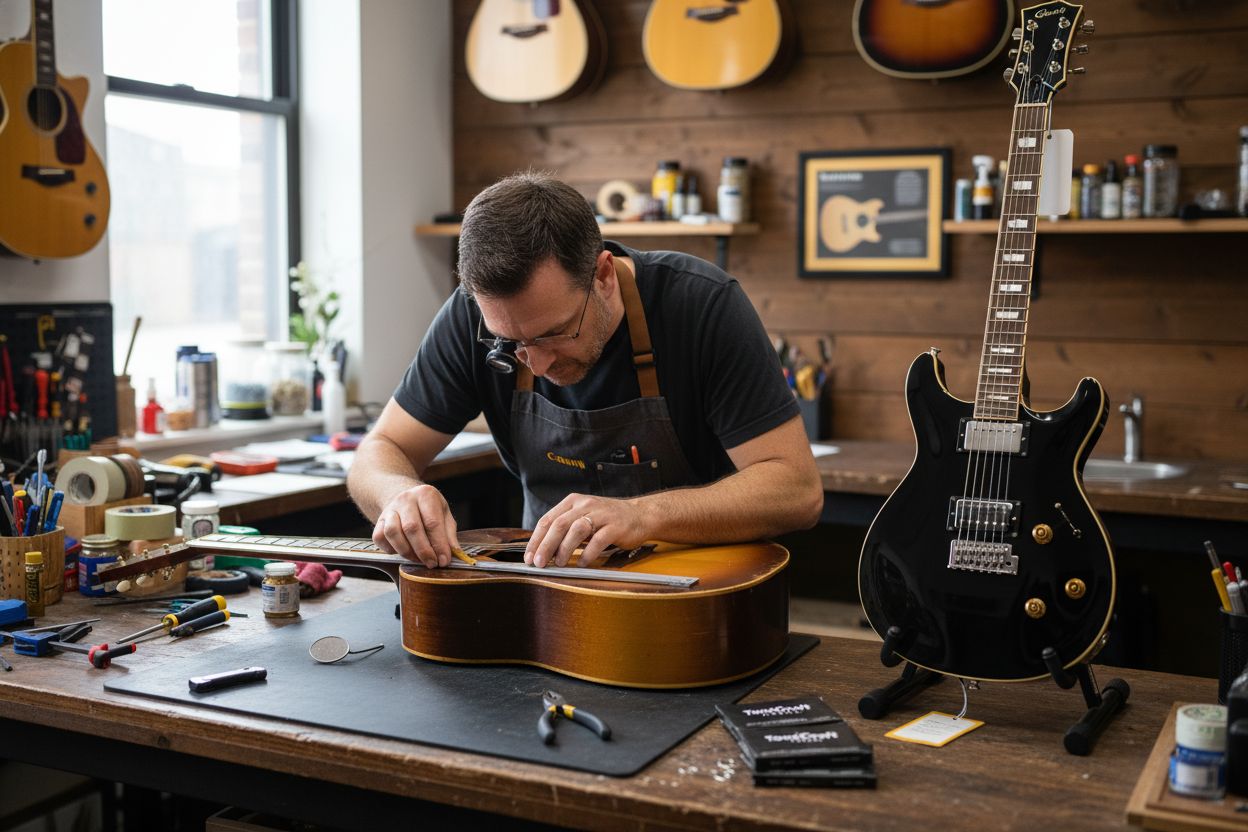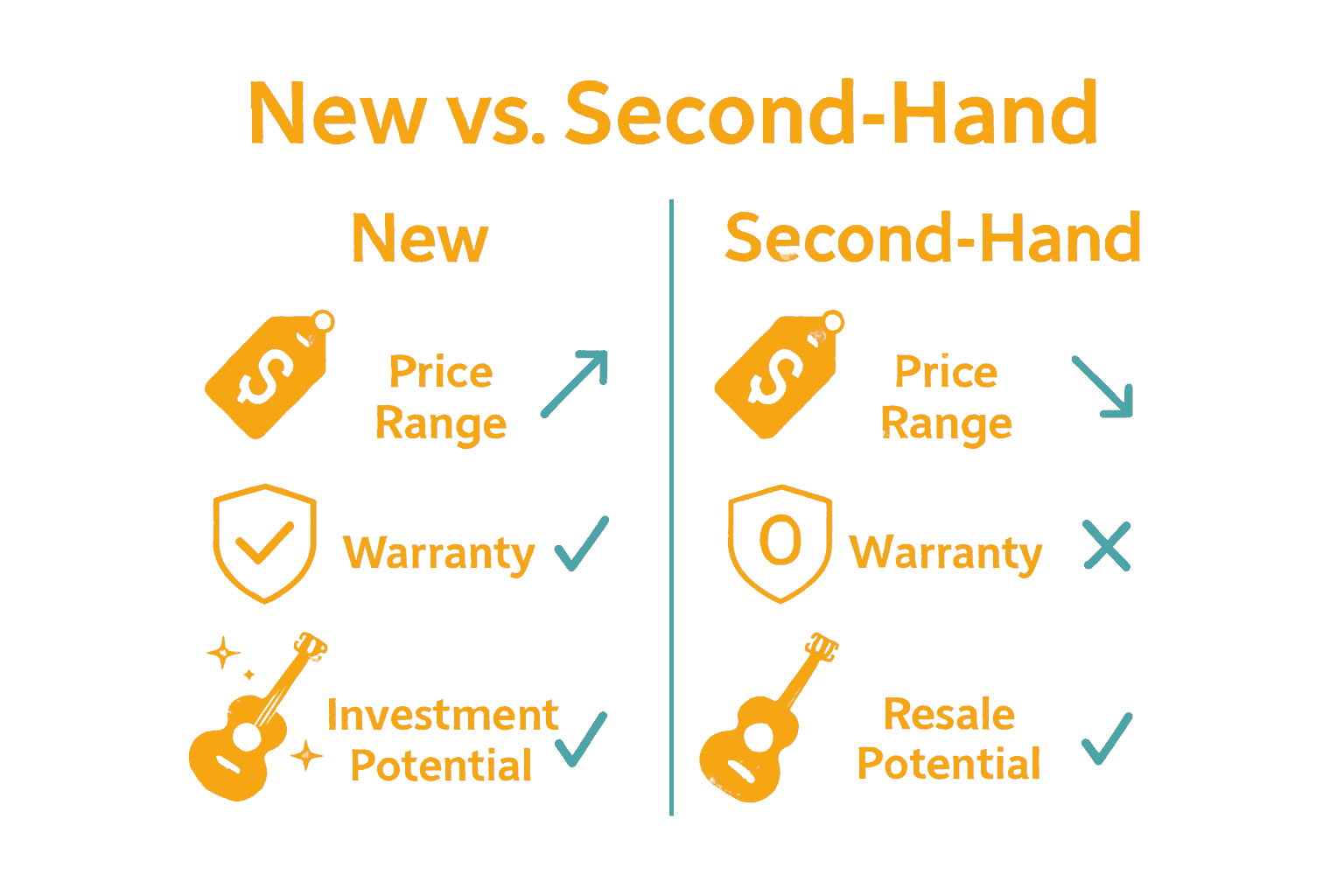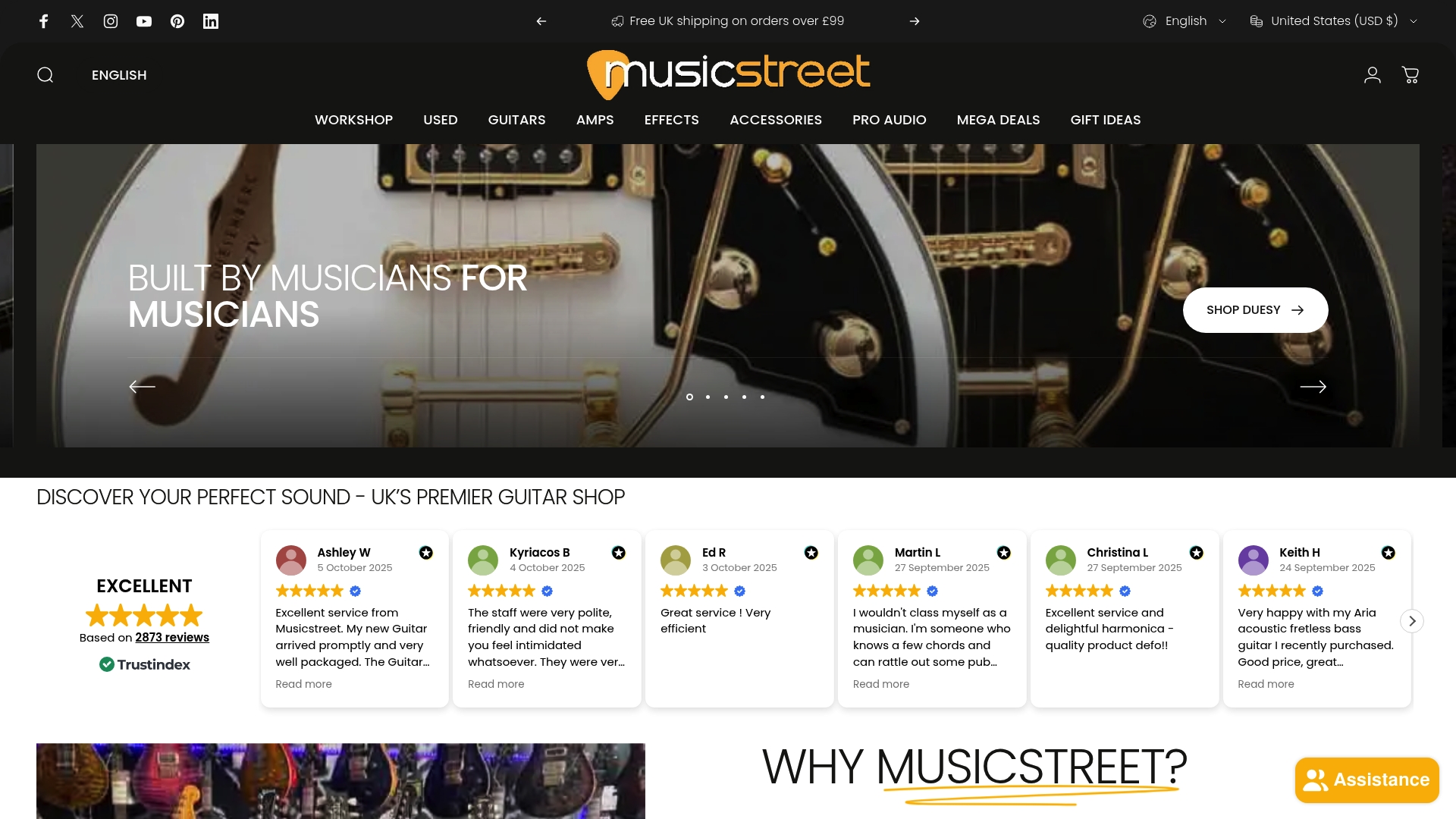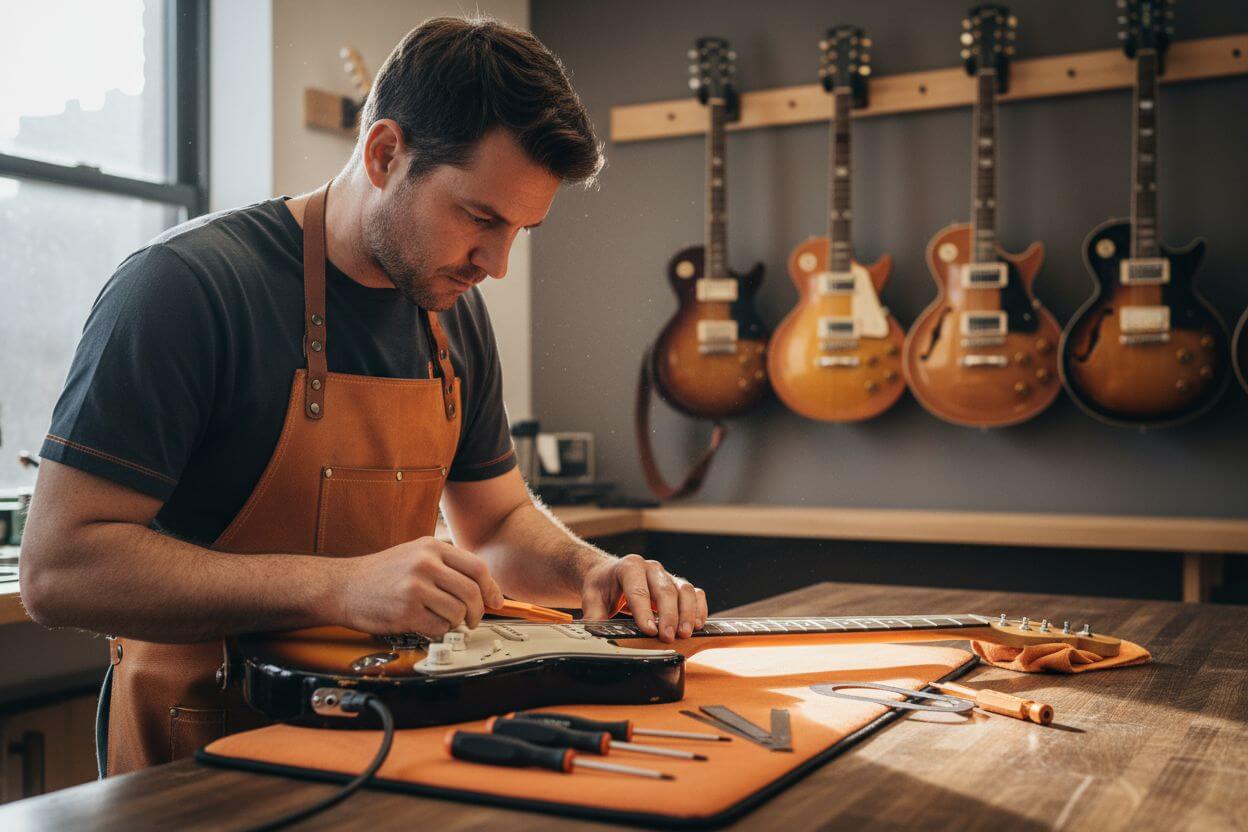Did you know that buying a second-hand guitar can save you up to 60 percent compared to a brand-new model? Choosing between new and used guitars is more than just a price decision. Each option shapes your sound, budget, and even your connection to the environment. By understanding the real differences, you can find an instrument that matches both your playing style and your long-term goals.
Key Takeaways
| Point | Details |
|---|---|
| Price Difference | New guitars are more expensive, while second-hand options typically reduce costs by 30-60%. |
| Condition and Playability | New guitars offer pristine condition, whereas second-hand guitars may provide a unique, ‘played-in’ feel. |
| Warranty and Support | New guitars come with full manufacturer warranties; second-hand options often lack comprehensive coverage. |
| Investment and Resale Potential | New guitars depreciate quickly, while rare second-hand models may appreciate over time, offering better investment potential. |
Table of Contents
- Defining Second Hand And New Guitars
- Comparing Guitar Condition And Playability
- Cost Differences And Value Retention
- Assessing Warranty, Support, And Safety
- Resale Potential And Long-Term Investment
Defining Second Hand and New Guitars
Here’s a comparison of new and second-hand guitar features:
| Feature | New Guitar | Second-Hand Guitar |
|---|---|---|
| Price | Higher Reflects newness |
Lower 30-60% below retail |
| Condition | Pristine No wear |
May show wear Played-in tone |
| Warranty | Full manufacturer coverage | Limited or none |
| Playability | Predictable Original setup |
Unique feel Matured wood |
| Value Retention | Fast initial depreciation | Slower depreciation Possible appreciation |
| Investment Potential | Standard for most models | Higher for rare/vintage models |
| Support | Manufacturer assistance | Seller-dependent or independent repair |
| Sustainability | New resources required | Environmentally friendly choice |
When exploring the world of guitars, understanding the fundamental differences between second-hand and new guitars becomes crucial for musicians at every skill level. According to research from MusiceCool, second-hand guitars represent pre-owned instruments that offer unique advantages beyond their price tag.
A second-hand guitar typically encompasses instruments that have been previously owned, played, and are now being resold. These guitars come with several distinctive characteristics:
- Potentially lower purchase price
- Vintage or rare models that might no longer be in production
- Instruments with unique playing histories
- Already “played-in” tone and sound
- More environmentally sustainable purchasing option
Conversely, new guitars are fresh from manufacturers, straight out of their packaging with zero prior playing history. They represent pristine instruments that provide musicians with guaranteed quality, manufacturer warranties, and the excitement of owning something untouched.
While second-hand guitars might carry stories and character, new guitars guarantee predictability. Our guide on buying new guitars can help you understand the nuances of selecting the perfect instrument that matches your musical journey and budget.
Comparing Guitar Condition and Playability
When choosing between a second-hand and new guitar, playability becomes a critical factor that can dramatically impact your musical experience. According to research from MusiceCool, used guitars often possess a unique characteristic that new guitars cannot replicate: a broken-in feel with maturing wood that can enhance both tone and playability.
Condition Considerations
Evaluating guitar condition involves several key aspects:
- Visual Inspection: Check for structural damages, wear marks, and potential repairs
- Neck Alignment: Assess straightness and potential warping
- Fretboard Wear: Examine fret condition and potential neck issues
- Hardware Functionality: Test tuning machines, bridge, and electronic components
Playability Factors
Playability goes beyond initial condition and involves how the instrument feels and responds. New guitars typically offer:
- Pristine fretboards
- Perfectly aligned necks
- Unused hardware
- Manufacturer’s original setup
Second-hand guitars, however, can provide unique playing experiences. The wood’s natural aging process can create a more resonant instrument with a smoother feel. Learn more about guitar craftsmanship in our high-end guitar guide.
Ultimately, individual instrument variation means each guitar demands personal assessment. While general guidelines help, nothing replaces physically playing and feeling the instrument’s unique character.

Cost Differences and Value Retention
Navigating the financial landscape of guitar purchasing requires understanding the nuanced economics of new versus second-hand instruments. While upfront costs might seem straightforward, the true value story goes far deeper than the initial price tag.
Price Breakdown
New guitars typically come with a premium price point, reflecting:
- Brand new manufacturing
- Full manufacturer warranty
- Pristine cosmetic condition
- Latest design and technology
Second-hand guitars offer a more budget-friendly entry, with prices often 30-60% lower than retail. Value depreciation works differently for guitars compared to other assets:
- Vintage and rare models can appreciate
- Well-maintained instruments hold significant resale potential
- Collector’s editions might increase in value over time
Investment Considerations
Smart musicians view guitars not just as instruments, but as potential investments. Some strategies include:
- Purchasing limited edition models
- Selecting guitars from respected manufacturers
- Maintaining excellent condition
- Documenting instrument provenance
Our comprehensive guide on high-end guitars can provide deeper insights into making financially savvy guitar purchases. Remember, the right guitar is an investment in your musical journey – its value extends far beyond monetary worth.
Assessing Warranty, Support, and Safety
When purchasing a guitar, warranty coverage and professional support become critical considerations that can significantly impact your long-term musical investment. New and second-hand guitars offer distinctly different approaches to protecting your instrument.
Warranty Landscape
New guitars typically provide comprehensive protection:
- Full manufacturer warranty
- Typically 1-2 years of coverage
- Direct support from original manufacturer
- Guaranteed replacement or repair of manufacturing defects
Second-hand guitars present a more nuanced warranty scenario:
- Often limited or no original manufacturer warranty
- Potential for third-party or seller-provided protection
- Importance of independent instrument inspection
Safety and Risk Management
Purchasing a second-hand guitar requires careful risk assessment. Essential safety checks include:
- Structural integrity examination
- Electronics functionality verification
- Detection of previous repairs or modifications
- Authenticity verification for collector’s items
Learn more about minimizing risks when buying used guitars with our comprehensive guide. Smart musicians understand that protection goes beyond paperwork – it’s about ensuring your instrument remains a reliable companion in your musical journey.
Resale Potential and Long-Term Investment
Understanding the financial trajectory of a guitar goes beyond its initial purchase price, transforming it from a mere musical instrument into a potential long-term investment. The resale landscape differs dramatically between new and second-hand guitars, offering unique opportunities for savvy musicians.
Depreciation and Value Dynamics
New guitars typically experience more significant depreciation:
- Lose approximately 20-30% of value within first year
- Rapid initial value drop similar to new car purchases
- Standard market model for mass-produced instruments
- Less predictable appreciation potential

Second-hand guitars present fascinating investment characteristics:
- Some models appreciate over time
- Vintage instruments can become valuable collector’s items
- Rare editions potentially increase in market value
- Lower initial investment reduces total financial risk
Strategic Investment Approaches
Smart guitar investment strategies include:
- Researching historically valuable guitar brands
- Maintaining excellent instrument condition
- Documenting instrument provenance and history
- Understanding market trends in guitar collecting
Explore our guide on high-end guitars to develop a nuanced understanding of guitar investment potential. Remember, the most valuable guitar is ultimately the one that inspires your musical passion.
Ready to Choose the Guitar That Truly Fits You?
Deciding between a second-hand and new guitar brings up tough questions about value, playability, and long-term investment. If you are wrestling with concerns about condition, tone, or justifying your budget, it is natural to want expert guidance and reassurance. MusicStreet understands the mixed feelings you may have after reading about the pros and cons of buying new versus pre-owned, especially when factors like warranty, resale value, and that unique ‘played-in’ tone can sway your decision.

Visit MusicStreet.co.uk to explore our handpicked range of meticulously checked new and used guitars, all supported by detailed product listings and clear pricing. Let our in-store experts offer advice tailored to your needs, whether you are after the dependable sparkle of a brand-new model or the character-rich resonance of a pre-owned gem. Discover what it feels like to shop with trust, transparency, and real community support. If you want to learn more about making a smart investment, our high-end guitar guide and risk-minimising tips for buying used await you. Now is the perfect time to take the next step towards your perfect guitar. Explore, compare, and discover your sound today.
Frequently Asked Questions
What are the main differences between second-hand and new guitars?
New guitars are pristine with full manufacturer coverage and predictable quality, while second-hand guitars may show wear, offer unique tones, and generally have lower price points.
Is it worth buying a second-hand guitar?
Yes, second-hand guitars can be environmentally friendly, often available at 30-60% lower prices, and may offer vintage or rare options that new guitars do not.
How does the playability of second-hand guitars compare to new ones?
Second-hand guitars often provide a unique and more ‘played-in’ feel due to the natural aging of the wood, enhancing tone and playability, whereas new guitars provide a uniform playing experience.
What should I consider regarding warranty and support for second-hand guitars?
Second-hand guitars usually come with limited or no original manufacturer warranty, so it’s important to assess the condition and functionality of the instrument and consider any seller-provided support or independent inspections.




Share:
Complete Guide to Professional Guitar Setups